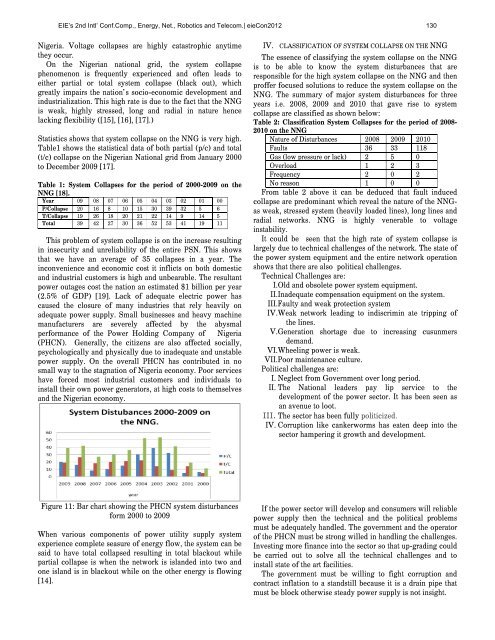Voltage Collapse and the Nigerian National Grid - Covenant ...
Voltage Collapse and the Nigerian National Grid - Covenant ...
Voltage Collapse and the Nigerian National Grid - Covenant ...
Create successful ePaper yourself
Turn your PDF publications into a flip-book with our unique Google optimized e-Paper software.
EIE’s 2nd Intl’ Conf.Comp., Energy, Net., Robotics <strong>and</strong> Telecom.| eieCon2012 130<br />
Nigeria. <strong>Voltage</strong> collapses are highly catastrophic anytime<br />
<strong>the</strong>y occur.<br />
On <strong>the</strong> <strong>Nigerian</strong> national grid, <strong>the</strong> system collapse<br />
phenomenon is frequently experienced <strong>and</strong> often leads to<br />
ei<strong>the</strong>r partial or total system collapse (black out), which<br />
greatly impairs <strong>the</strong> nation’s socio-economic development <strong>and</strong><br />
industrialization. This high rate is due to <strong>the</strong> fact that <strong>the</strong> NNG<br />
is weak, highly stressed, long <strong>and</strong> radial in nature hence<br />
lacking flexibility ([15], [16], [17].)<br />
Statistics shows that system collapse on <strong>the</strong> NNG is very high.<br />
Table1 shows <strong>the</strong> statistical data of both partial (p/c) <strong>and</strong> total<br />
(t/c) collapse on <strong>the</strong> <strong>Nigerian</strong> <strong>National</strong> grid from January 2000<br />
to December 2009 [17].<br />
Table 1: System <strong>Collapse</strong>s for <strong>the</strong> period of 2000-2009 on <strong>the</strong><br />
NNG [18].<br />
Year 09 08 07 06 05 04 03 02 01 00<br />
P/<strong>Collapse</strong> 20 16 8 10 15 30 39 32 5 6<br />
T/<strong>Collapse</strong> 19 26 18 20 21 22 14 9 14 5<br />
Total 39 42 27 30 36 52 53 41 19 11<br />
This problem of system collapse is on <strong>the</strong> increase resulting<br />
in insecurity <strong>and</strong> unreliability of <strong>the</strong> entire PSN. This shows<br />
that we have an average of 35 collapses in a year. The<br />
inconvenience <strong>and</strong> economic cost it inflicts on both domestic<br />
<strong>and</strong> industrial customers is high <strong>and</strong> unbearable. The resultant<br />
power outages cost <strong>the</strong> nation an estimated $1 billion per year<br />
(2.5% of GDP) [19]. Lack of adequate electric power has<br />
caused <strong>the</strong> closure of many industries that rely heavily on<br />
adequate power supply. Small businesses <strong>and</strong> heavy machine<br />
manufacturers are severely affected by <strong>the</strong> abysmal<br />
performance of <strong>the</strong> Power Holding Company of Nigeria<br />
(PHCN). Generally, <strong>the</strong> citizens are also affected socially,<br />
psychologically <strong>and</strong> physically due to inadequate <strong>and</strong> unstable<br />
power supply. On <strong>the</strong> overall PHCN has contributed in no<br />
small way to <strong>the</strong> stagnation of Nigeria economy. Poor services<br />
have forced most industrial customers <strong>and</strong> individuals to<br />
install <strong>the</strong>ir own power generators, at high costs to <strong>the</strong>mselves<br />
<strong>and</strong> <strong>the</strong> <strong>Nigerian</strong> economy.<br />
Figure 11: Bar chart showing <strong>the</strong> PHCN system disturbances<br />
form 2000 to 2009<br />
When various components of power utility supply system<br />
experience complete seasure of energy flow, <strong>the</strong> system can be<br />
said to have total collapsed resulting in total blackout while<br />
partial collapse is when <strong>the</strong> network is isl<strong>and</strong>ed into two <strong>and</strong><br />
one isl<strong>and</strong> is in blackout while on <strong>the</strong> o<strong>the</strong>r energy is flowing<br />
[14].<br />
IV. CLASSIFICATION OF SYSTEM COLLAPSE ON THE NNG<br />
The essence of classifying <strong>the</strong> system collapse on <strong>the</strong> NNG<br />
is to be able to know <strong>the</strong> system disturbances that are<br />
responsible for <strong>the</strong> high system collapse on <strong>the</strong> NNG <strong>and</strong> <strong>the</strong>n<br />
proffer focused solutions to reduce <strong>the</strong> system collapse on <strong>the</strong><br />
NNG. The summary of major system disturbances for three<br />
years i.e. 2008, 2009 <strong>and</strong> 2010 that gave rise to system<br />
collapse are classified as shown below:<br />
Table 2: Classification System <strong>Collapse</strong>s for <strong>the</strong> period of 2008-<br />
2010 on <strong>the</strong> NNG<br />
Nature of Disturbances 2008 2009 2010<br />
Faults 36 33 118<br />
Gas (low pressure or lack) 2 5 0<br />
Overload 1 2 3<br />
Frequency 2 0 2<br />
No reason 1 0 0<br />
From table 2 above it can be deduced that fault induced<br />
collapse are predominant which reveal <strong>the</strong> nature of <strong>the</strong> NNGas<br />
weak, stressed system (heavily loaded lines), long lines <strong>and</strong><br />
radial networks. NNG is highly venerable to voltage<br />
instability.<br />
It could be seen that <strong>the</strong> high rate of system collapse is<br />
largely due to technical challenges of <strong>the</strong> network. The state of<br />
<strong>the</strong> power system equipment <strong>and</strong> <strong>the</strong> entire network operation<br />
shows that <strong>the</strong>re are also political challenges.<br />
Technical Challenges are:<br />
I. Old <strong>and</strong> obsolete power system equipment.<br />
II. Inadequate compensation equipment on <strong>the</strong> system.<br />
III. Faulty <strong>and</strong> weak protection system<br />
IV. Weak network leading to indiscrimin ate tripping of<br />
<strong>the</strong> lines.<br />
V. Generation shortage due to increasing cusunmers<br />
dem<strong>and</strong>.<br />
VI. Wheeling power is weak.<br />
VII. Poor maintenance culture.<br />
Political challenges are:<br />
I. Neglect from Government over long period.<br />
II. The <strong>National</strong> leaders pay lip service to <strong>the</strong><br />
development of <strong>the</strong> power sector. It has been seen as<br />
an avenue to loot.<br />
III. The sector has been fully politicized.<br />
IV. Corruption like cankerworms has eaten deep into <strong>the</strong><br />
sector hampering it growth <strong>and</strong> development.<br />
If <strong>the</strong> power sector will develop <strong>and</strong> consumers will reliable<br />
power supply <strong>the</strong>n <strong>the</strong> technical <strong>and</strong> <strong>the</strong> political problems<br />
must be adequately h<strong>and</strong>led. The government <strong>and</strong> <strong>the</strong> operator<br />
of <strong>the</strong> PHCN must be strong willed in h<strong>and</strong>ling <strong>the</strong> challenges.<br />
Investing more finance into <strong>the</strong> sector so that up-grading could<br />
be carried out to solve all <strong>the</strong> technical challenges <strong>and</strong> to<br />
install state of <strong>the</strong> art facilities.<br />
The government must be willing to fight corruption <strong>and</strong><br />
contract inflation to a st<strong>and</strong>still because it is a drain pipe that<br />
must be block o<strong>the</strong>rwise steady power supply is not insight.
















